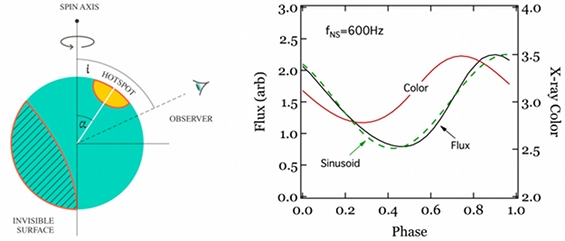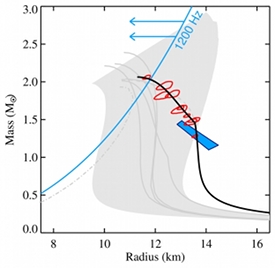Determining the equation of state with LOFT
To measure the Equation of State (EOS), one requires a set of measurements of mass (M) and radius (R) spanning a range of masses. This mass-radius relation can then be inverted to obtain the functional form of the EOS. One of LOFT's main strengths as a dense-matter mission is that it will employ three different primary techniques to measure M and R: pulse profile modelling, spin measurements, and asteroseismology. The use of multiple techniques and different source types allows independent cross-checks on the EOS.
Modelling Pulse Profiles
 |
| As a neutron star rotates, emission from the hotspot generates a pulse profile. The energy-dependence of the pulse profile properties enables us to infer mass and radius. Credit: ESA |
The flux we observe from a bright spot on the neutron star surface offset from the rotational pole will be modulated by the star's rotation. This periodic modulation at the spin frequency is called pulsation. As the photons propagate through the curved space-time of the star, information about M and R is encoded into the shape of the pulse profile.
Spin Measurements
At the very simplest level, one can obtain constraints from the most rapidly rotating neutron stars. The limiting spin rate, at which the equatorial surface velocity is comparable to the local orbital velocity and "mass-shedding" occurs, is a function of M and R and hence fast spins constrain the EOS parameter dependencies can be resolved. The current record holder, which spins at 716 Hz does not provide any constraint. However LOFT can measure faint objects with faster spins, so in principle different forms of EOS can be ruled out. Between 1 kHz and 1.25 kHz, for example, individual EOS of nucleonic matter would be excluded.
Seismology
The detection of seismic vibrations in neutron stars is one of RXTE's most exciting discoveries, as it allows a unique, direct view of the densest bulk matter in the Universe. Vibrations, detectable as quasi-periodic oscillations in hard X-ray emission, were found in the decays of two so-called 'giant flares' from two magnetars. Such giant flares are rare, occurring only every ~10 years, but less bright intermediate flares, occur every year. These flares are too brief (~1 second) to permit detection of similar oscillations with current instrumentation. LOFT will be sensitive to these intermediate flares with similar fractional amplitudes as those observed in the tails of giant flares, by photons leaking through the collimator outside the field of view.
Potential outcome with LOFT
 |
|
Measurements of neutron star masses and radii (red ellipses), will give very tight constraints on the dense matter Equation of State. Credit: ESA |
LOFT will be the first mission to make precision measurements of mass (M) and radius (R) for a sufficiently large sample of neutron stars to enable reconstruction of the full functional form of the EOS. An example of how LOFT might eventually achieve this is shown here. Constraints are shown from pulse profile modelling (red contours) of several hypothetical neutron stars, from a 1200 Hz intermittent pulsar (EOS must extend to the left of the blue line, as shown), and from seismic vibrations in a magnetar intermediate flare (blue box). In the scenario shown, the results from pulse profile modelling suggested a hybrid EOS (flattening at high mass, kink at intermediate mass). The spin and seismic data are consistent with this EOS. The best fit hybrid EOS is shown in black, other models in grey.
